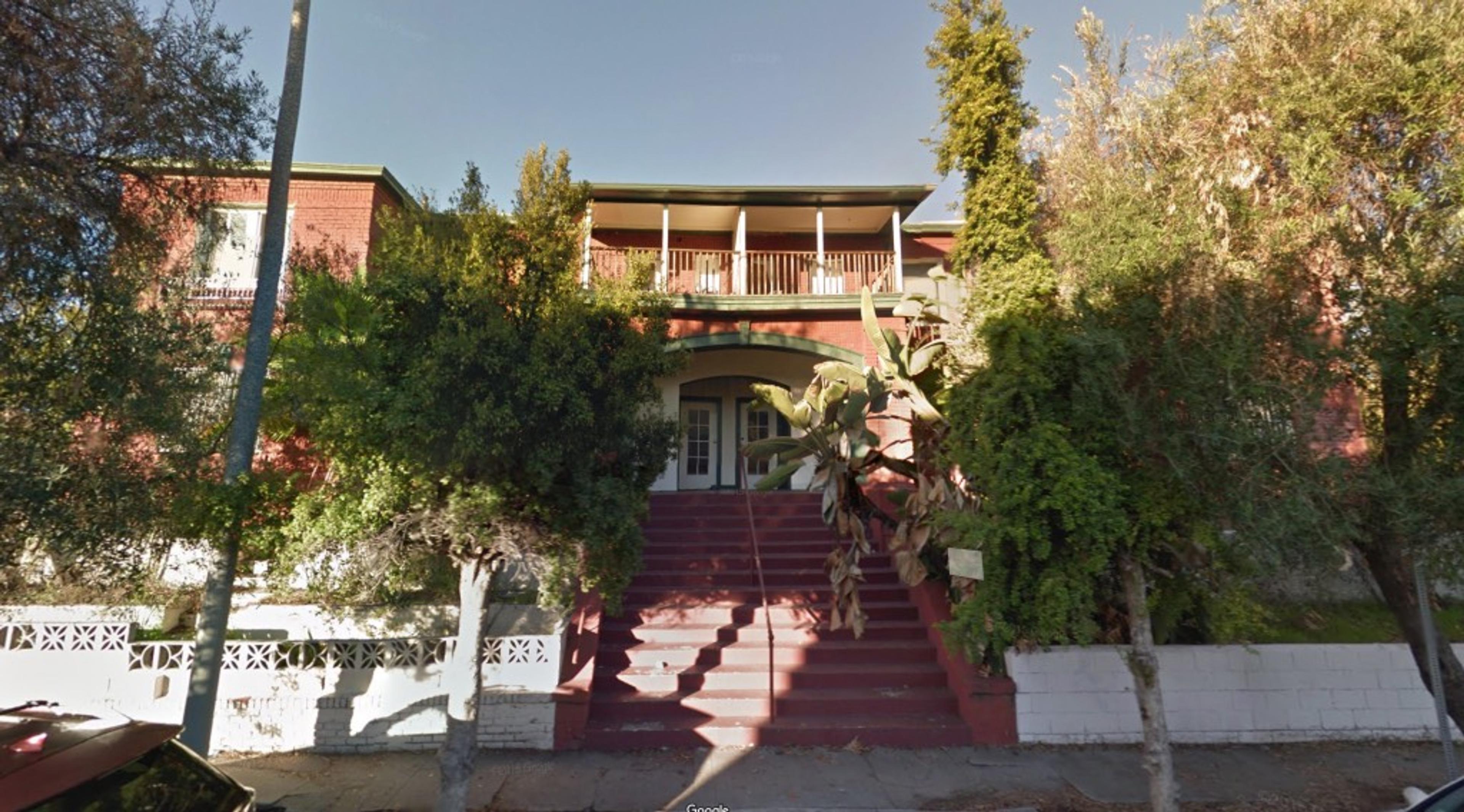A certain overgrown charm
For our first post, we’ll take a look at 371-377 North St. Andrews Place, at the southwest corner of St. Andrews and Elmwood Avenue.
Permits are pulled in March 1919 for a $16,000 twenty-room fourplex of flats; the Assessor pegs it as being built in 1921. The four-unit apartment house was owned by F. G. Fritz, who had hired Edward Butler Rust as the architect, and Luther T. Mayo as contractor.
Architect Rust is best known for his Los Altos Apts. Another of Rust’s fourplexes, also from 1921, was recently made a Historic-Cultural Monument. Other notable works of Rust’s are the ill-fated 1927 Hotel Californian on Sixth, the nearly ill-fated 1928 Versailles down St. Andrews, the National Register Maryland Apartments in Pasadena, and, from later in his oeuvre, the Art Deco Linder Residence of 1938.
371 a handsome structure. I like the bilateral symmetry, the keystone arch, the Monterey balcony.
But as they were quick to point out in the listing, fix it up or tear it down:
Can you guess which they’ve elected to do?
Five stories, with a zoning variance to make it fifty-six feet high. No more banana palms and wide stairs, this thing will be built to the edges of the property on all sides, because they got a zoning variance for that, too. I can tell you what it will look like, and I bet they haven’t even hired an architect yet. It will be your typical wood frame over concrete box, with some jagged part to the façade to give it “character” and some pastel color to give it “humanity.” It will use flat windows, rainscreen cladding to create the skin of the building, fiber cement Hardie panels. It will be depthless. It will express the essential vacuity of the 21st century.
Mostly, it will be fifty-six feet tall. Let’s look around the neighborhood a bit:
Looking east on Elmwood across St. Andrews Place; 371 behind the palm. It’s a two-story neighborhood.
Looking west on Elmwood; hard to miss 371, dark-red as she is, center-left
North on St. Andrews. (I trust you’ve noticed the two incredible matching flats at the southeast corner. They were built in 1919 and designed by A. B. Crist, who built the first house in Hollywoodland.)
And looking south on St. Andrews._ _371 to the left behind the bushy tree.
Why am I showing you all these captures through the intersection? To indicate there’s nothing remotely so modern and monstrous around. That’s what’s plopped down here. Because, you know, it’s a half-mile from a bus stop.
Does that make sense? That’s the ambit of TOC (and the density brownshirts). It’s all out-of-state developers lighting cigars with dollar bills. Worse yet, it’s social engineers like Mark Vallianatos and his comrade Scott Wiener as they try to force upzoning on cities.
And that’s our first post! Keep coming back!
Because your neighborhood is next.
- [North Saint Andrew’s Place](https://www.google.com/maps/search/?api=1&query=34.07783,-118.31146)
About Nathan Marsak
NATHAN MARSAK says: “I came to praise Los Angeles, not to bury her. And yet developers, City Hall and social reformers work in concert to effect wholesale demolition, removing the human scale of my town, tossing its charm into a landfill. The least I can do is memorialize in real time those places worth noting, as they slide inexorably into memory. In college I studied under Banham. I learned to love Los Angeles via Reyner’s teachings (and came to abjure Mike Davis and his lurid, fanciful, laughably-researched assertions). In grad school I focused on visionary urbanism and technological utopianism—so while some may find the premise of preserving communities so much ill-considered reactionary twaddle, at least I have a background in the other side. Anyway, I moved to Los Angeles, and began to document. I drove about shooting neon signs. I put endless miles across the Plains of Id on the old Packard as part of the 1947project; when Kim Cooper blogged about some bad lunch meat in Compton, I drove down to there to check on the scene of the crime (never via freeway—you can’t really learn Los Angeles unless you study her from the surface streets). But in short order one landmark after another disappeared. Few demolitions are as contentious or high profile as the Ambassador or Parker Center; rather, it is all the little houses and commercial buildings the social engineers are desperate to destroy in the name of the Greater Good. The fabric of our city is woven together by communities and neighborhoods who no longer have a say in their zoning or planning so it’s important to shine a light on these vanishing treasures, now, before the remarkable character of our city is wiped away like a stain from a countertop. (But Nathan, you say, it’s just this one house—no, it isn’t. Principiis obsta, finem respice.) And who knows, one might even be saved. Excelsior!””
Nathan’s blogs are: Bunker Hill Los Angeles, RIP Los Angeles & On Bunker Hill.
